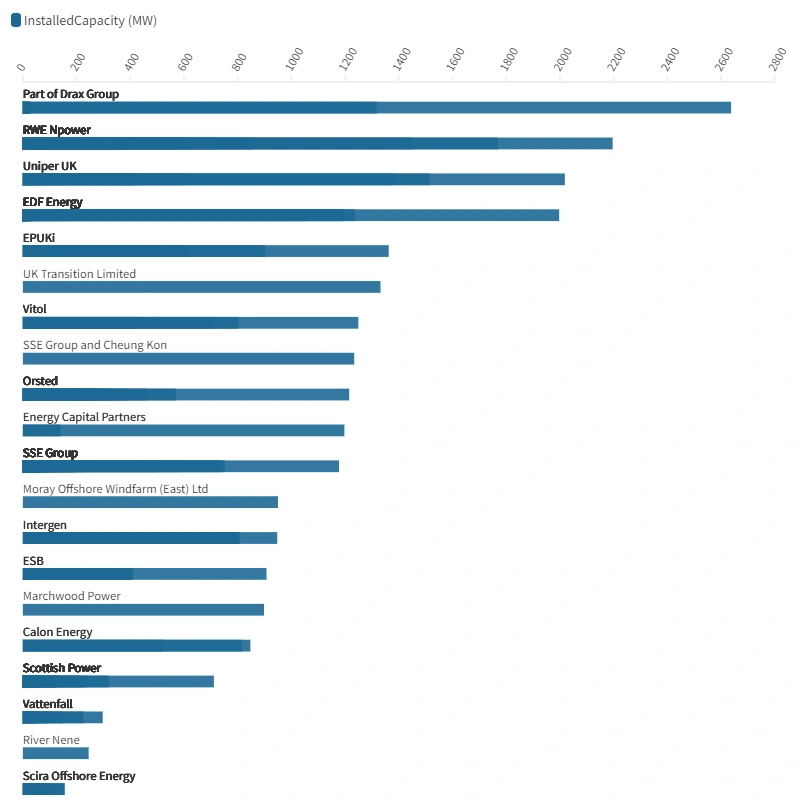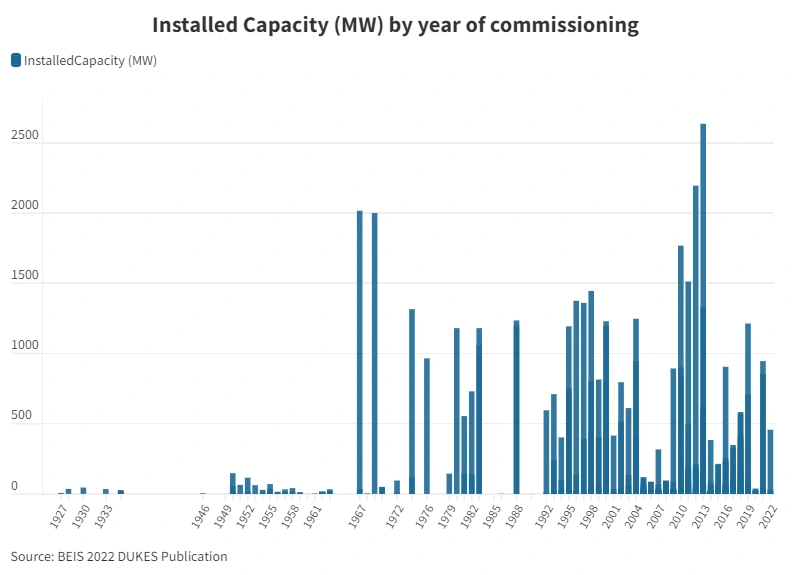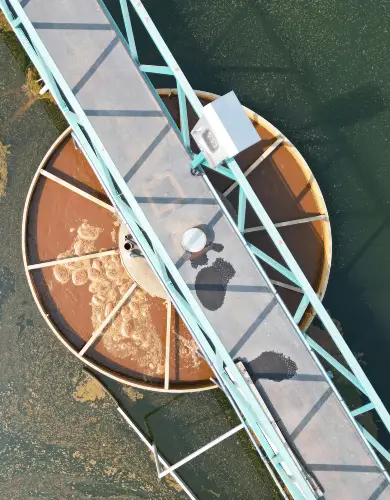Data Insights: Power generation in the UK
Did you know that the UK has thousands of independent power generators distributed across the country? Were you aware that Scotland produces the cleanest electricity and gives out a large portion of it to the rest of the UK?
Or are we still consuming electricity from pre-war generators quietly churning power in the Scottish and Welsh highlands?
We analysed the latest data from BEIS and found some gems
Contents
- Solar, wind and hydro need more but produce less
- Power generators are all over the UK
- Scotland, Wales and NI give power to England
- Low-carbon electricity is a Scottish affair
- The world owns the UKs power generation
- We still consume hydropower installed before WW2
- The constant flux of energy transition
- Conclusion
- External Resources
Solar, wind and hydro need more but produce less
There are 1,313 power generators in the UK according to the latest BEIS database of 2022, of which the vast majority are small-scale solar and wind generators spread across the country, showing the sheer scale of the UK distributed grid in terms of numbers.
This is largely positive for consumers and micro-generators, as well as local electricity resilience and diversification, but it is certainly more difficult to manage and scale.
Numbers do not translate to electricity output with these types of fuels, as the vast majority of electricity powering the national grid comes from centralised natural gas, nuclear, biomass, and large offshore wind farms
International electricity imports have also become significant, and a single new connection can greatly increase the amount of power the UK receives.
Power generators are all over the UK
Electricity generation is happening all over the country, and chances are there is a generator within 20 miles of your home. It’s in the mountains, farms, coasts, reservoirs, industrial areas, and remote islands.
The map below shows the location of the vast majority of the UK’s 1313 power generators as per the BEIS database (some are not displayed)
Our energy experts found the following trends from the map:
- Solar power has been more widely installed in the southern part of the country, where sunlight hours and intensity are higher.
- Micro-hydro power is concentrated in the mountains and hills of Scotland and Wales.
- Wind turbines are found all over the place at varying scales. We found there is a higher-than-average concentration near the Scotland-England border.
- Remote Scottish islands are powered by small-scale oil/diesel generators.
- Natural gas and coal power stations are also evenly distributed.
- Most of the generators are owned by business energy suppliers.
Scotland, Wales and NI ‘export’ power to England
Compared to their population and economic output, Scotland, Wales, and NI produce a larger proportion of electricity than what is consumed locally.
While some of this is exported abroad (e.g. NI electricity is shared with Ireland), most of it goes to support the electricity consumption of power-hungry England.
Low-carbon electricity is a Scottish affair
In other news, Scotland also clearly has the lowest-carbon power generation in the UK, with nuclear, wind and hydro making up over three-quarters of its power generation.
This is significantly different to the power generation of England, Wales and NI, which are particularly dominated by fossil fuels and the often questionable biomass power, which is England’s main source of renewable electricity
The world owns the UK’s power generation
Power generators in the UK have been operated by private companies ever since the 1990s deregulation of the electricity generation market.
Since then, 58 national and international companies and consortiums have been operating the 1313 power generators in the UK for profit.
To keep it brief, here are the top 20 power generation companies by installed power capacity in the UK:

This list clearly shows the global ownership of UK power generation, showing there is no such thing as “British” power.
Eight (8) are from the UK, two (2) are from Germany and the U.S, and one (1) is French, Czech, Dutch, Danish, Irish and Swedish, although many are, in fact, UK subsidiaries or international consortiums that include multi-national companies and asset managers from all over the world.
Otherwise, Drax Group have the largest capacity as they operate Drax (the largest power station in the UK) as well as other hydroelectric, biomass and wind energy projects.
EDF Energy (4th) is a wholly-owned subsidiary of the French state-owned Électricité de France (EDF) and essentially own all of the nuclear power stations in the UK.
Orsted (9th) are a Danish company that owns the largest share of the installed offshore wind capacity, while Scottish Power (17th) own the largest onshore share.
These top 20 companies own and operate >80% of the total installed capacity of the UK.
We still consume hydropower installed before WW2
If you switch over to the hydro tab on the dashboard above, you’ll notice a couple of power generators that were commissioned in the late 1920s and early 1930s that are still in operation today!
This persistent capacity belongs to ten Scottish and one Welsh hydropower generator that have a capacity of about 230 MW, enough to power around 200,000 homes! To put it into perspective, nuclear hadn’t even been invented then…
We thought the energy mentality would change post-war, but in fact, almost all of the installed capacity commissioned until 1963 that is STILL IN USE today is hydropower, making it by far the most robust energy source and probably the most cost-effective being in operation for well over 50 years!
The constant flux of energy transition

When plotting all installed capacity in one graph it becomes clear that electricity generation has actually been transitioning since the 1960s with the installation of nuclear energy.
Then in the 1980s-90s came the tsunami of natural gas plants as the North Sea fields provided ample cheap fuel to power these and replace some of the ageing coal power stations that were still operational then. Natural gas is cleaner than coal, so technically, decarbonisation was happening as early as this.
Without this built capacity, the rapid phasing out of coal power would have been impossible, as intermittent renewables are not a full replacement for baseload fossil fuels until they can be combined with energy storage and a much larger international electricity import capacity.
We’re definitely entering a new phase in the energy transition with the rise of wind and solar over the last two decades, yet it’s clear that the stage was being set well before this!
Conclusion
The media is often flooded with unnecessary noise about how power is generated in the UK.
Perhaps most of us have a narrow view of what electricity production looks like, but the reality is, in fact, much more colourful, varied and full of curiosities.
Power generation in the UK is diverse, increasingly low-carbon and largely owned and operated by a global consortium of companies that most of us have never even heard about.
In any case, if you found this article interesting, be sure to check out our blog, and if you’re looking to compare business energy for your business, be sure to try our electricity comparison tools.

